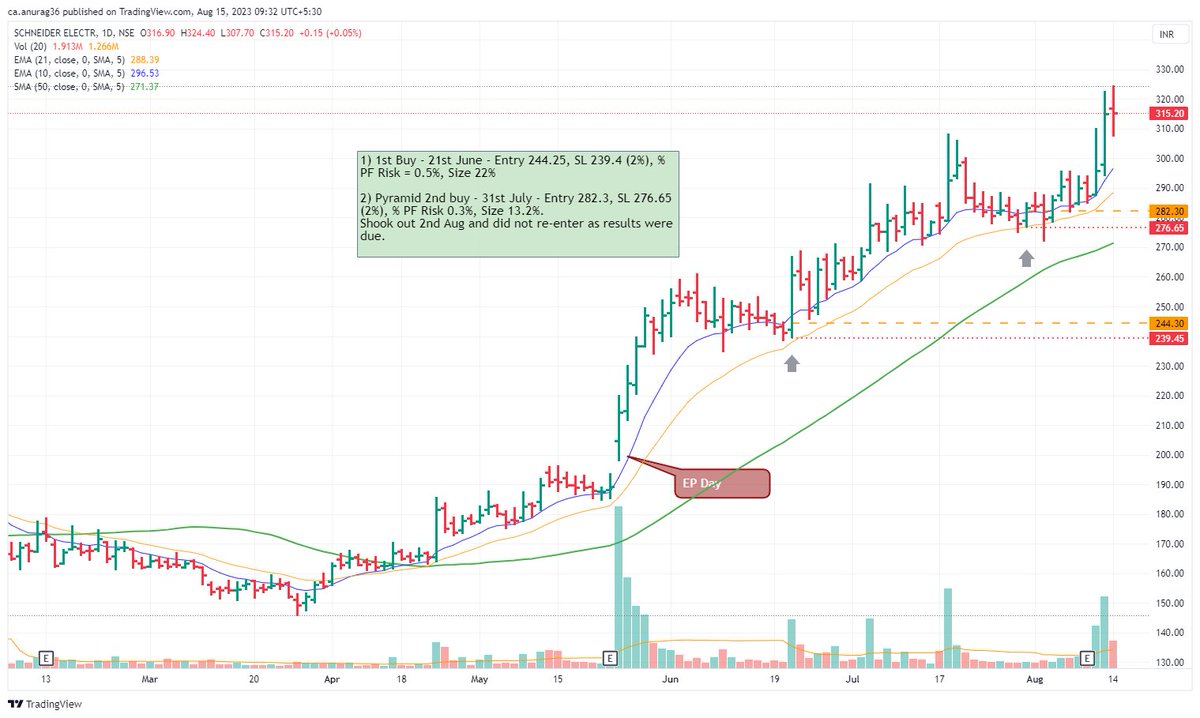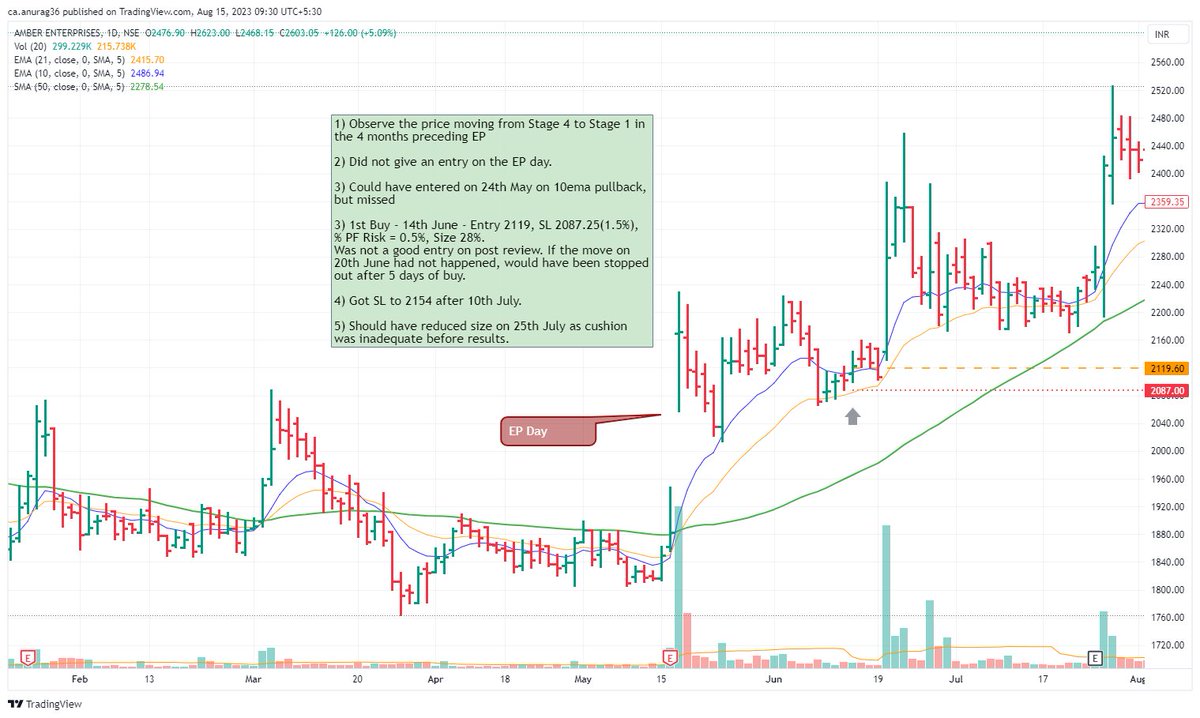The Episodic Pivot is a misunderstood setup in Indian fintwit. When @PradeepBonde or @Qullamaggie trade EP, execution is tailored to the US markets, which have no circuit limits and allow trades during off-market hours.
Here is an EP playbook for the Indian markets:
The Basics
EP is the ultimate lovechild of a trader and a fundamental investor.
Why you should trade EP
- It focuses on getting you into the stock as close as possible to the origin of the move and captures a large part of the upmove.
- It has one of the best effort-to-reward ratios among any setups, making it a vital tool for achieving superior performance for non-fulltime traders.
- EP stocks typically receive a lot of institutional liquidity, making it a scalable strategy.
Why EP works
The fundamental trigger for an EP is new information that catches the market off guard and forces a revaluation of the stock. This creates a sense of FOMO and urgency to buy or sell the stock, resulting in explosive moves. When combined with the institutional need of getting a decent allocation in their "big" portfolio, it often sustains the trend for many months, especially for low float stocks.
The cause (Why) of new information surprise and FOMO is an inherent and eternal market principle. Many traders use the same principle by different names, but for simplicity's sake, I will refer to it as EP, which is the name I learned from @PradeepBonde .
There are basically two types of EP...
Earnings EP - The Stock Bee rule of requiring a 30%+ growth in sales and EPS on a yoy and qoq basis generally serves well even in Indian markets. However, since I am not actively monitoring the market during trading hours and cannot check earnings in real-time, I only focus on earnings reports that are released after the market closes.
Non-Earnings EP - everything else that has an indirect impact on earnings, such as new orders (e.g., RVNL, JBMA, Anuras this year), new government policies (sugar, fertiliser stocks), among others.
My EP universe is mostly focused on earnings which are released after market hours. They have been more than sufficient.
Deep Dive
In 2022, We conducted a deep dive even though we had been trading EPs for a while before that. We analysed 1688 gap ups from January 2017 to March 2022 with regard to reported earnings, potential entry points, trailing methods, and pyramiding chances.
How to identify EP
- When analysing post-market results, my primary focus is on a qoq and yoy growth of at least 30% in both EPS and sales. However, this is not a strict requirement. I simply want to see unexpected, positive growth. In addition, a bullish earnings presentation, such as NDTV's February 2022 EP, can be helpful.
- For a stock to be considered an EP, it must either gap up or open strongly the next day**. If it fails to do so, then it cannot be considered as an EP since the market is not surprised by the results.
- The stock must be neglected, meaning it is either in a big base consolidation or down trending. Based on my observations, stocks in consolidation tend to perform better than those that are down trending. This is a significant criterion for me because it correlates with the potential magnitude of the up move.
- To identify EP stocks, look for stocks that have gapped up on strong results announced after the previous day's close. This can be done during the pre-open.
- I do not use volume as a decision-making criterion because I buy very early, and it cannot be relied upon at that stage. Although I filter out stocks below a market cap of <300 crore.
(Note - This is different from an earnings gap up. The crucial aspect is a shift in the narrative or trend; the context of the gap-up holds greater significance than the gap-up itself. The charts will clearly show that something significant has changed. It is a new episode in the life of the company and its share price.)
How to buy EP
The key to capturing most of the EP move is to find and enter as early as possible. This trade should become risk-free quickly since the setup is based on an urgency to act. If the trade stalls or takes too long to move, it is more likely to fail.
On the day of EP
In our deep dive, we observed getting in on the 5 minute opening range highs with the day low stop loss (often the breakout bar low too) worked well. I skip entries where the gap up plus opening range highs are more than 12%. This is because the circuit limit restrains the upmove and does not make my trade risk-free on the same day.
During our in-depth analysis, we noted that less than 45% of the EPs were triggered on the gap day. However, most of those that did trigger provided immediate risk-free, low-cost entries that could be used to support higher-risk pyramid positions. My win rate for these trades has fluctuated between 40-60%, with a stop loss between 2-4%.
EP Pullback
Most EPs will offer a pullback entry around the 10/21 EMA. These are high risk-reward points for entry and pyramiding. This is often useful for stocks where the earnings were not great, but the market's reaction was. Here are some of my EP pullback buys from this year that I still hold (see post on June 18th).



Commonalities in buys - a tight/negative bar close to moving averages, an entry near the previous day's high on a strong start, and a stop loss (SL) near the day's low.
Reverse EP
Although I do not frequently use this strategy, it works very well with momentum stocks that are showing signs of topping off. Many large profitable prop desks use this strategy to short on EP days or write calls for longer trends. Instead of spoon feeding examples, I encourage you to search for these stocks yourself. You can begin by looking at the Jan-March 2022 quarter.
How to Sell EP
EP is a primary case for selling in weakness. The trend is new and the urgency to buy has just begun. Typically, you can expect to get around 10-20 strong EPs per year. Therefore, holding positions with an "all or nothing" perspective yielded better results in the Deep Dive. Even though EPs account for less than 10% of my total trades, they have contributed to more than 35% of my returns in the last 2 years.
Every pullback to the 10/21 EMA is a pyramiding opportunity for me. I will exit the position if the 21 EMA is breached (i.e. if the low of the bar closing below the moving average is broken). Alternatively, if the distance between the 21 EMA and 50 DMA is not too large, I may use the latter to exit the position.
The only time to sell into strength is during temporary extensions (15% away from 10ema), or to maintain your mental confidence with the intention of buying back again.
P.S. - "We" in the Deep dive - Me, @swing_ka_sultan, @ashfan_harjee, @SaumilSanghavi, @tetarmihir, @_ASHUTOSHVARMA
.jpg)